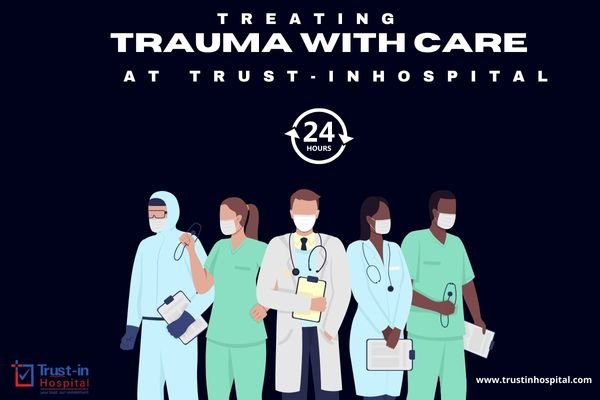What Are The 5 Important Steps To Be Followed For A Trauma Care Patient?
Having 1 million lives lost to traumatic accidents in India alone, it is crucial to understand the 5 most important steps followed for a trauma care patient. Trauma care for the patient begins before arrival at the hospital by local emergency aid providers which include Basic Life Support (BLS), Advanced Cardiac Life Support (ACLS), and Pediatrics Advanced Life Support (PALS). The moment a patient is brought into the emergency department, a team of best doctors in Horamavu enquires about the ambulance staff, witnesses and any individuals involved in the accident to understand the severity and nature of the accident. Meanwhile, the patient is connected to a pulse oximeter, cardiac monitor, and a blood pressure machine to record the vital signs. Once the situation is gauged, the trauma care patient goes through the primary survey beginning with sequential steps of A.B.C.D.E with the most vital areas taking precedence.
● Airway
● Breathing
● Circulation
● Disability
● Exposure/environmental control
Understanding ABCDE:
Now that we have understood the primary trauma care provided to the patient, let's move on to understanding the first step of investigation - the Airway.
Airway
When the patient is attended to, one person stands at the head of the bed and assesses the situation of the airway of the patient to locate any of the following obstacles:
● Foreign bodies
● Swelling in the tongue
● Blood
● Vomitus, or
● Saliva
However, the classic technique adopted by trauma care doctors is to question and engage in conversation with the patient by asking for any difficulty in breathing, talking or any coarseness in the throat, etc. Once the airway is treated,the best doctors in Horamavu move on to investigate the breathing.
Breathing
Once the airway is dealt with, best doctors in Horamavu move on to assessing the next step in the primary survey (ABCDE) , i.e, Breathing. One may consider airway and breathing to be the same concepts. However, do note, airway is the path for oxygen to enter and carbon dioxide to leave the body, whereas, breathing is a mechanism which involves the following parts:
● Lungs
● Diaphragm
● Chest wall / ribs
● Intercostal muscles, and
● Intercostal neuro-vasculature
Once the physical examination is complete, the patient is sent for imaging to eliminate the following:
● Fractures
● Diaphragmatic injury
● Pleural effusion,
● Pneumothorax,
● Parenchymal injury,
● Foreign bodies, etc.
Assessing the above is essential to eliminate any obstruction while breathing as well as identify internal bleeding so as to avoid cardiovascular complications. A trauma care patient needs to be assessed thoroughly by a team of doctors who are specialised in emergency care.
Circulation
Once breathing is assessed and all complications have been successfully dealt with, the patient’s circulation is looked into. The essential components of a circulatory system are the heart, blood and the vasculature. Looking into any deformities that obstruct blood flow in the body can be detrimental to any vital organs. Areas of concern for a trauma patient are usually mechanical, pressure and electrical related injuries which can affect blood flow within the body.
After recording vital signs of the patient, it is crucial for the doctor to check for strength and presence of central v/s peripheral pulses and how they compare bilaterally. Next, the doctor needs to examine the patient’s skin colour/decolouration, warmth and any obvious deformities that can affect the blood flow. To eliminate possibilities of internal bleeding and blood vessel ruptures is through the following imaging modalities:
● CT exam
● X-Ray
● Ultrasound
Internal bleeding is harmful as it can lead to major blockages within arteries and further cause more complications.
Disability
This section of the survey involves the neurological status of the trauma patient which is determined using the following tools:
● Glasgow Coma Scale (GCS)
● Pupillary size and response
● Blood glucose levels, and
● Drug and alcohol levels.
If the patient shows deficit in any of the above categories, they are rushed for CT imaging of the brain as well as the cervical spine to investigate further.
Exposure/Environmental Control
Having understood the 4 stages of primary survey which relate to the patient’s airway, breathing, cardiovascular activity, and neurological deficits, let's move on to the final stage- exposure. In this stage, the team of doctors at hospital in Horamavu remove clothing, articles or any protective layering from the patient to uncover lacerations, bruises and any other injuries having been hidden earlier. Keeping in mind the body temperature of the patient, trauma bays are built with higher temperatures than the rest of the emergency ward.
This level of concern is shown at the Trust-in Hospital, a multispeciality hospital situated in Horamavu, Bangalore with over 15+ departments, 24/7 emergency care along with ICU, Imaging, Pharma, and much more.
Conclusion:
Once the primary care is taken care of, the team of doctors at the hospital in Horamavu draft an ideal course of treatment depending on the results from the above tests and imaging. Keeping the patient’s comfort in mind, they are provided with extra care whenever required. Call Trust-in Hospital at +91-80-45174949 / +91-8050706071 / 72 for their quick response and hassle free emergency team.
Author Profile:
Trust-in Hospital is a major multi-speciality medical hospital in Bangalore. Its mission is to provide high-quality, personalised healthcare to patients. The best and most skilled specialists work at this cutting-edge hospital. It integrates advanced medical technologies and modern infrastructure to provide comprehensive and cost-effective care to both outpatients and inpatients using a multidisciplinary approach.
Know further:
https://www.trustinhospital.com/
https://www.trustinhospital.com/contact-us
